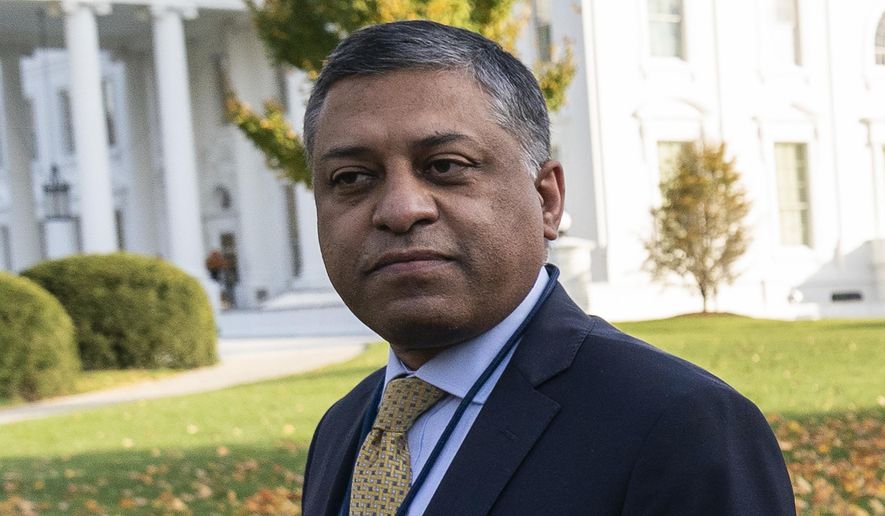The White House drug czar told Congress on Wednesday that he is designating the combination of fentanyl and “tranq” as an emerging threat, underscoring the level of alarm around a vicious drug mixture that causes skin abscesses and amputations and is worsening the deadly overdose crisis.
Dr. Rahul Gupta, the director of the Office of National Drug Control Policy, said the designation should lead to limits on imports of xylazine, the formal name for tranq, while raising awareness and speeding the development of treatments.
It will also force him to deliver a plan to Congress within 90 days that includes “deliverable actions” to address the threat. This is the first time a drug policy director has tapped into “emerging threat” powers that Congress granted the White House in a 2018 law.
“It couldn’t come at a more critical time,” Dr. Gupta said. “I’m deeply concerned about what this threat means for the nation.”
Veterinarians and ranchers use xylazine as an animal sedative. Drug users combine it with synthetic opioids to extend the feeling of euphoria. Xylazine also increases the risk of overdose and death and can cause infections and ulcers that force doctors to remove limbs.
The DEA says 23% of the fentanyl powder and 7% of fentanyl-laced pills that agents seized in 2022 contained xylazine. U.S. leaders say xylazine swamped the Northeast in recent years but then blanketed the nation, leading to soaring overdose rates.
More than 100,000 Americans die each year from drug overdoses. The deaths are driven by the prevalence of fentanyl, which is often made by Mexican cartels using Chinese chemicals.
While the rate of overdose deaths involving any drug flattened or declined slightly in 2022, xylazine-related deaths soared in all sectors of the nation, threatening to undo progress.
Xylazine-positive overdose deaths increased by 1,127% in the South, 750% in the West, more than 500% in the Midwest and over 100% in the Northeast between 2020 and 2021, Dr. Gupta said.
Chronic use of xylazine also narrows the blood vessels that provide oxygen to the skin. Without sufficient oxygen, the skin is susceptible to ulcers, abscesses, and infections that can lead to amputation. Withdrawal symptoms are so severe that some patients leave health settings even when it isn’t medically advisable.
Dr. Gupta formally designated the xylazine-fentanyl combo an emerging threat under powers established by Congress in the Support Act of 2018. Lawmakers pushed the idea to detect and respond to new drug threats before they become full-blown crises, realizing the U.S. was too slow to respond to other deadly scourges.
“Just imagine if this was possible for fentanyl or methamphetamine,” Dr. Gupta said.
He said the administration will craft a plan that tackles six points:
• It will look at ways to expand testing for xylazine in the drug supply. Right now, it is sorely lacking. “Many communities are not even aware of this threat in their backyard,” Dr. Gupta said.
• It will call for better data collection, so the government can understand the prevalence of illicit xylazine.
• It will gather experts to develop a better course of clinical care for persons suffering from addiction to fentanyl and xylazine, so doctors know how to stabilize patients and address withdrawal symptoms.
• It will wade into regulatory matters, including whether Congress needs to put illicit xylazine on the schedule of restricted drugs with a high risk of abuse.
• It will call in experts and drugmakers to develop an antidote for patients addicted to xylazine.
• Force the government to examine where xylazine is coming from — whether it is clandestine labs or diversion from manufacturers in China or U.S. — and search for other additives that might be added to fentanyl down the road.
Lawmakers and experts said xylazine is not subject to the Controlled Substances Act, so there is poor tracking and monitoring of its importation and use. Toxicology labs do not test for it regularly, so the trajectory of the problem remains murky.
Keith Humphreys, a Stanford University professor who tracks the opioid crisis, said Dr. Gupta’s designation will be an “excellent test case” for the powers that Congress granted the drug policy director.
He said the designation is having a positive effect already, given that media coverage will help people understand what xylazine is and the damage it is causing.
It should also focus the attention of federal agencies and Congress on illicit xylazine “while there is still time to prevent its spread throughout the U.S.,” he said.
Members of Congress have sounded the alarm about the threat in recent weeks.
Senate Majority Leader Charles E. Schumer told the administration to direct more dollars and labor to local authorities who are combatting xylazine. Bipartisan lawmakers said they want to put xylazine on the Schedule III list of drugs to spur better tracking and enforcement of penalties for illicit use.
Xylazine is not an opioid, so overdose-reversing drugs like naloxone are not effective against it.
Experts still recommend administering naloxone, saying there is no downside to attempting to resuscitate someone who is experiencing a suspected overdose.
The Food and Drug Administration recently moved to make a nasal spray version, Narcan, available over the counter and without a prescription.
• Tom Howell Jr. can be reached at thowell@washingtontimes.com.




Please read our comment policy before commenting.